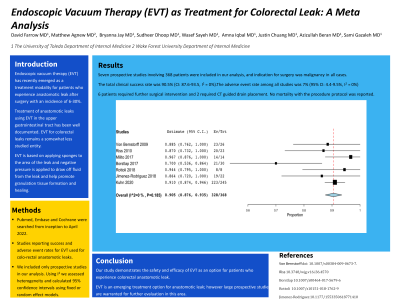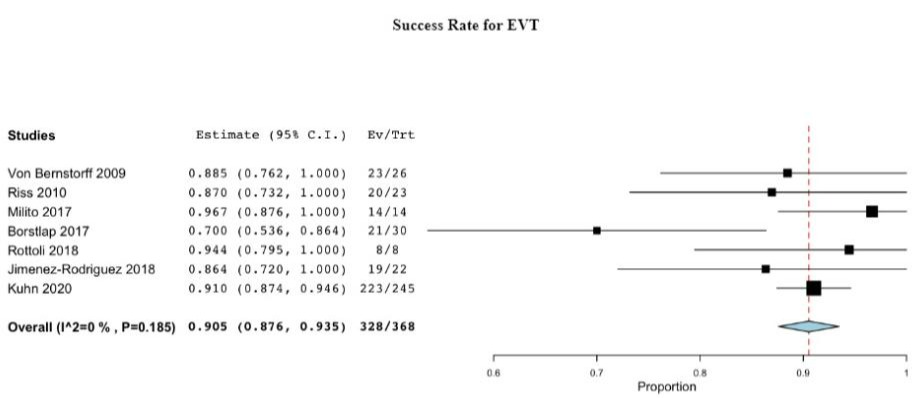Back


Poster Session B - Monday Morning
Category: Colon
B0089 - Use of Endoscopic Vacuum Therapy to Repair Colonic Anastomotic Leaks: A Meta-Analysis
Monday, October 24, 2022
10:00 AM – 12:00 PM ET
Location: Crown Ballroom

Has Audio

David Farrow, MD
University of Toledo
Toledo, Ohio
Presenting Author(s)
David Farrow, MD1, Matthew Agnew, MD2, Bryanna Jay, MD1, Sudheer Dhoop, MD1, Wasef Sayeh, MD1, Amna Iqbal, MD1, Justin Chuang, MD1, Azizullah A. Beran, MD3, Sami Ghazaleh, MD1
1University of Toledo, Toledo, OH; 2Wake Forest University School of Medicine, Winston-Salem, NC; 3The University of Toledo, Toledo, OH
Introduction: Endoscopic vacuum therapy (EVT) has recently emerged as a treatment modality for patients who experience anastomotic leak after surgery with an incidence of 6-30%. Treatment of anastomotic leaks using EVT in the upper gastrointestinal tract has been well documented. However, endoscopic vacuum therapy for colorectal leaks remains a somewhat less studied entity. EVT is based on applying sponges to the area of the leak and negative pressure is applied to draw off fluid from the leak and help promote granulation tissue formation and healing. In our study we aim to use prospective studies to assess the success and rates of adverse events using EVT for colo-rectal anastomotic leaks.
Methods: Pubmed, Embase and Cochrane were searched from inception to April 2022 for studies reporting success and adverse event rates for EVT used for colo-rectal anastomotic leaks. We included only prospective studies in our analysis. Using I2 we assessed heterogeneity and calculated 95% confidence intervals using fixed or random effect models.
Results: Seven studies involving 368 patients were included in our analysis. Indication for surgery was malignancy in all cases. The total clinical success rate was 90.5% (CI: 87.6-93.5. I2 = 0%). The adverse event rate among all studies was 7% (95% CI: 4.4-9.5%, I2 = 0%). Six patients required further surgical intervention and 2 required CT guided drain placement. No mortality with the procedure protocol was reported.
Discussion: EVT is an emerging treatment option for anastomotic leak. Our study demonstrates the safety and efficacy of EVT as an option for patients who experience colorectal anastomotic leak, however large prospective studies are warranted for further evaluation in this area.

Disclosures:
David Farrow, MD1, Matthew Agnew, MD2, Bryanna Jay, MD1, Sudheer Dhoop, MD1, Wasef Sayeh, MD1, Amna Iqbal, MD1, Justin Chuang, MD1, Azizullah A. Beran, MD3, Sami Ghazaleh, MD1. B0089 - Use of Endoscopic Vacuum Therapy to Repair Colonic Anastomotic Leaks: A Meta-Analysis, ACG 2022 Annual Scientific Meeting Abstracts. Charlotte, NC: American College of Gastroenterology.
1University of Toledo, Toledo, OH; 2Wake Forest University School of Medicine, Winston-Salem, NC; 3The University of Toledo, Toledo, OH
Introduction: Endoscopic vacuum therapy (EVT) has recently emerged as a treatment modality for patients who experience anastomotic leak after surgery with an incidence of 6-30%. Treatment of anastomotic leaks using EVT in the upper gastrointestinal tract has been well documented. However, endoscopic vacuum therapy for colorectal leaks remains a somewhat less studied entity. EVT is based on applying sponges to the area of the leak and negative pressure is applied to draw off fluid from the leak and help promote granulation tissue formation and healing. In our study we aim to use prospective studies to assess the success and rates of adverse events using EVT for colo-rectal anastomotic leaks.
Methods: Pubmed, Embase and Cochrane were searched from inception to April 2022 for studies reporting success and adverse event rates for EVT used for colo-rectal anastomotic leaks. We included only prospective studies in our analysis. Using I2 we assessed heterogeneity and calculated 95% confidence intervals using fixed or random effect models.
Results: Seven studies involving 368 patients were included in our analysis. Indication for surgery was malignancy in all cases. The total clinical success rate was 90.5% (CI: 87.6-93.5. I2 = 0%). The adverse event rate among all studies was 7% (95% CI: 4.4-9.5%, I2 = 0%). Six patients required further surgical intervention and 2 required CT guided drain placement. No mortality with the procedure protocol was reported.
Discussion: EVT is an emerging treatment option for anastomotic leak. Our study demonstrates the safety and efficacy of EVT as an option for patients who experience colorectal anastomotic leak, however large prospective studies are warranted for further evaluation in this area.

Figure: Success rate of EVT for anastomotic leaks
Disclosures:
David Farrow indicated no relevant financial relationships.
Matthew Agnew indicated no relevant financial relationships.
Bryanna Jay indicated no relevant financial relationships.
Sudheer Dhoop indicated no relevant financial relationships.
Wasef Sayeh indicated no relevant financial relationships.
Amna Iqbal indicated no relevant financial relationships.
Justin Chuang indicated no relevant financial relationships.
Azizullah Beran indicated no relevant financial relationships.
Sami Ghazaleh indicated no relevant financial relationships.
David Farrow, MD1, Matthew Agnew, MD2, Bryanna Jay, MD1, Sudheer Dhoop, MD1, Wasef Sayeh, MD1, Amna Iqbal, MD1, Justin Chuang, MD1, Azizullah A. Beran, MD3, Sami Ghazaleh, MD1. B0089 - Use of Endoscopic Vacuum Therapy to Repair Colonic Anastomotic Leaks: A Meta-Analysis, ACG 2022 Annual Scientific Meeting Abstracts. Charlotte, NC: American College of Gastroenterology.
